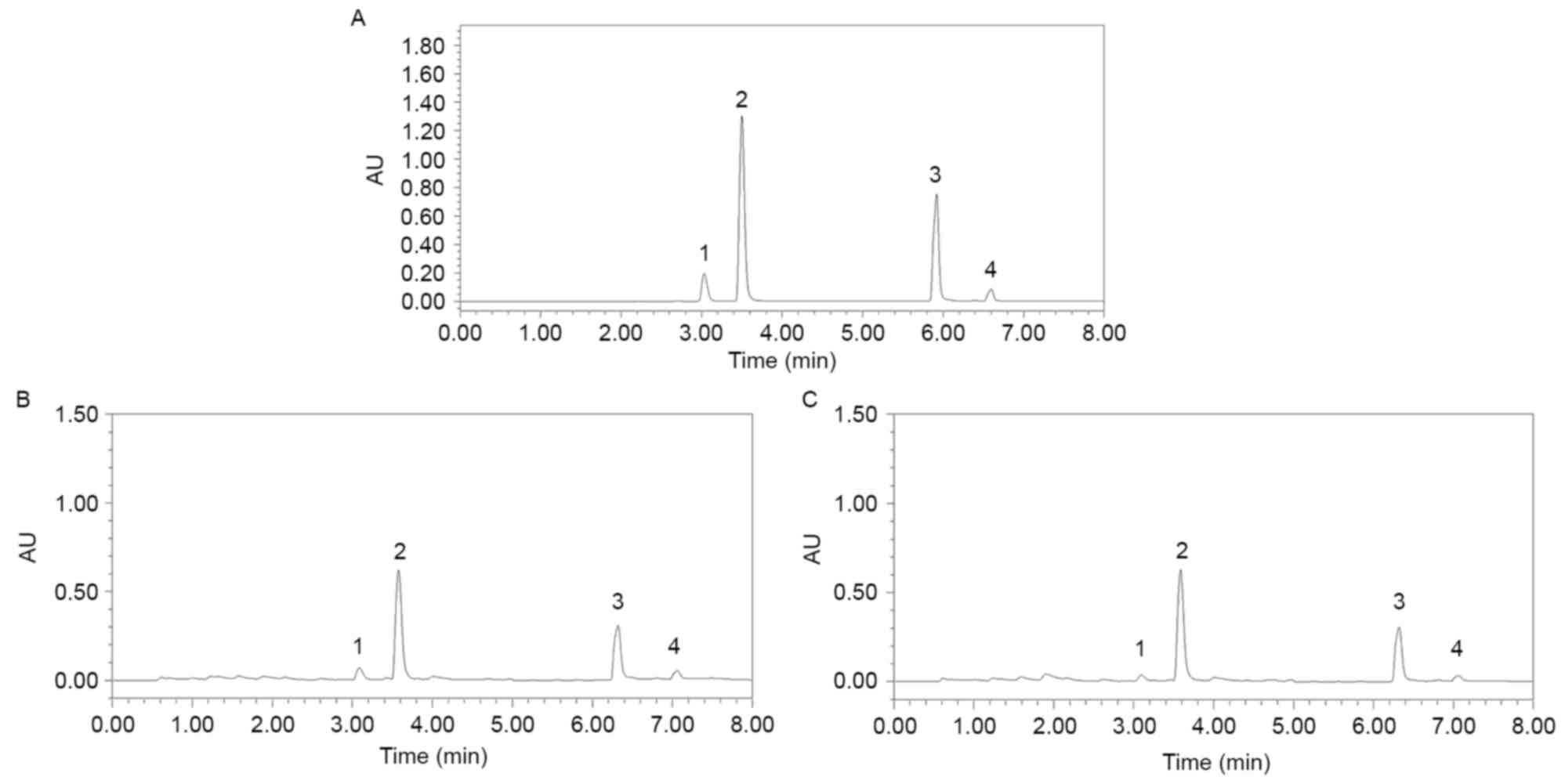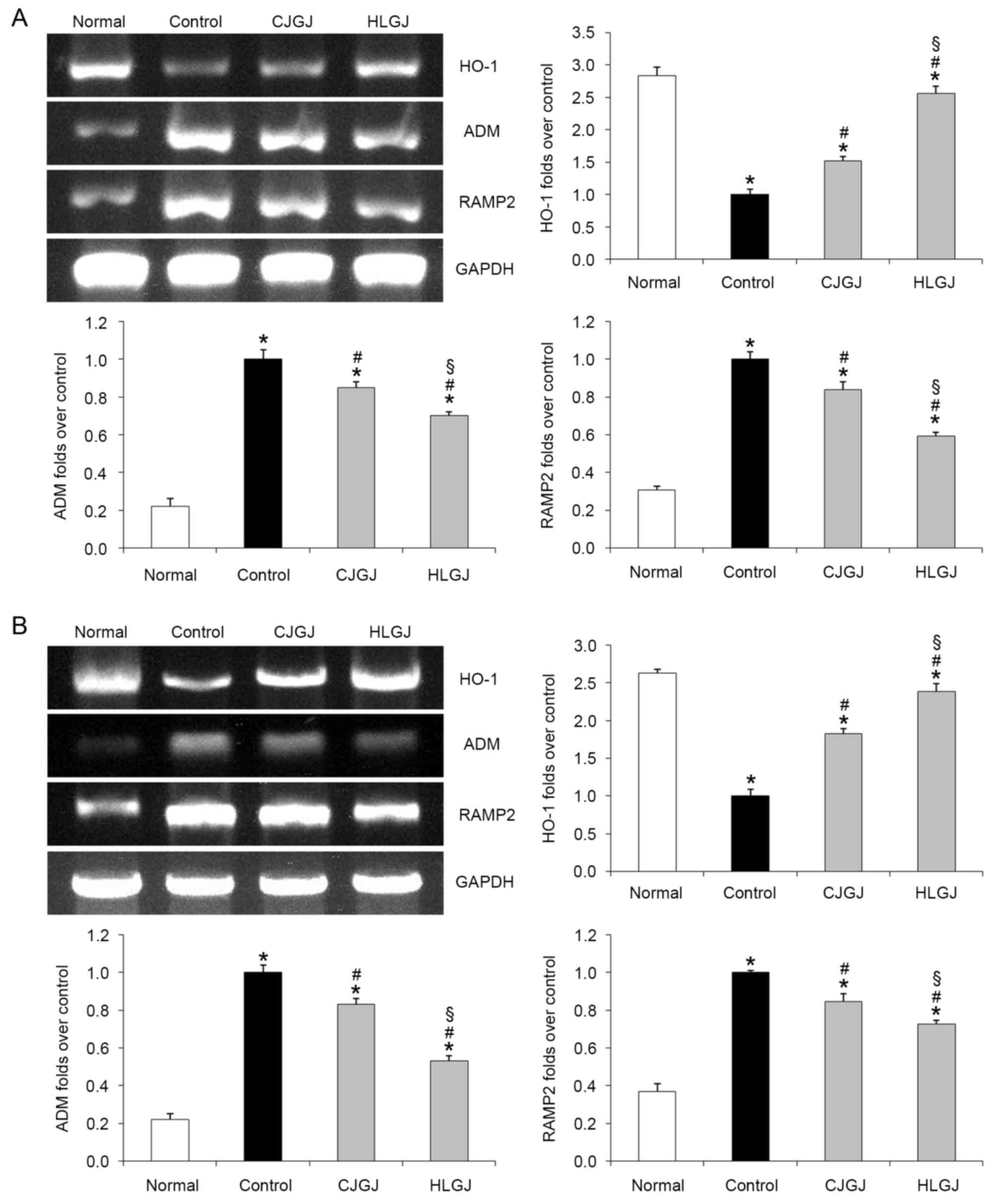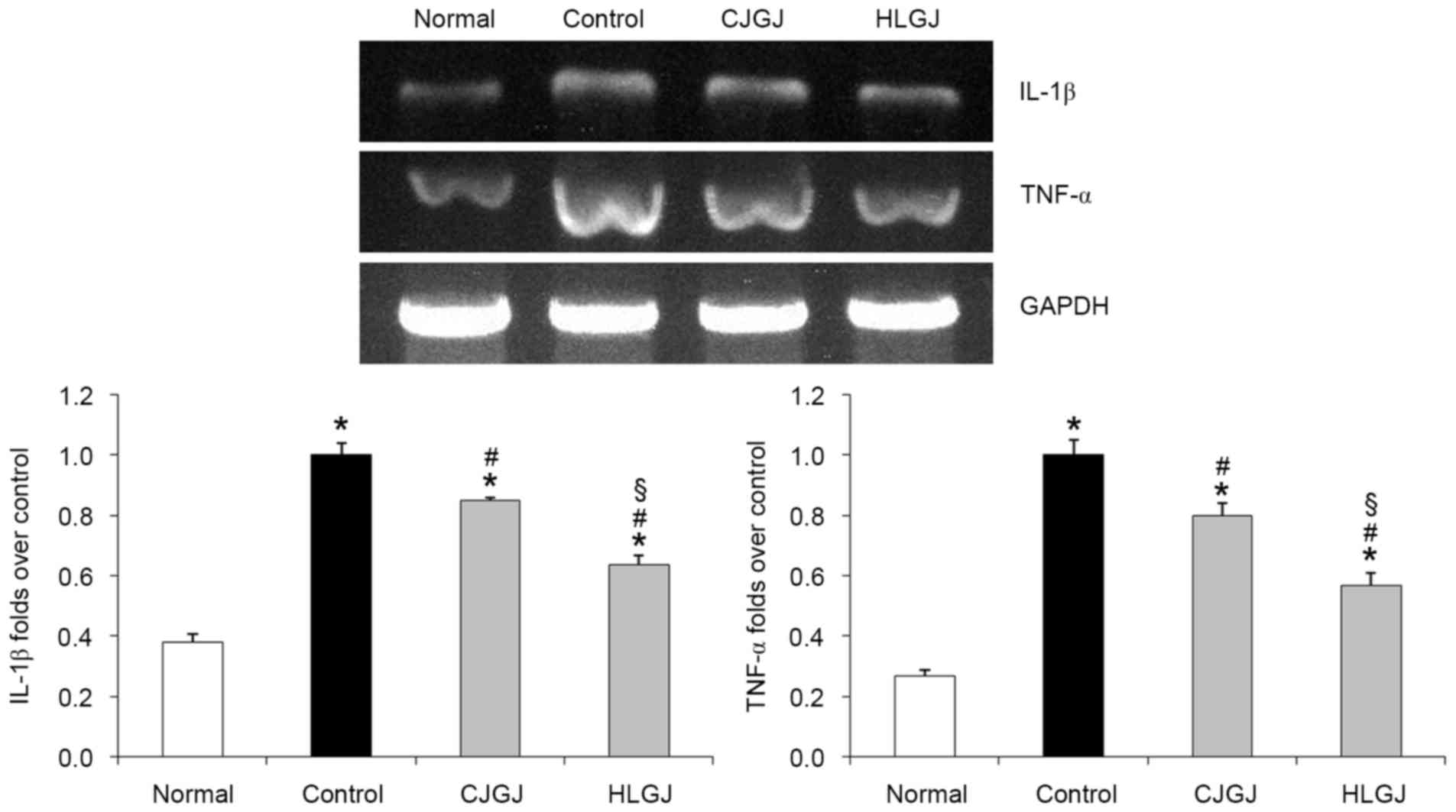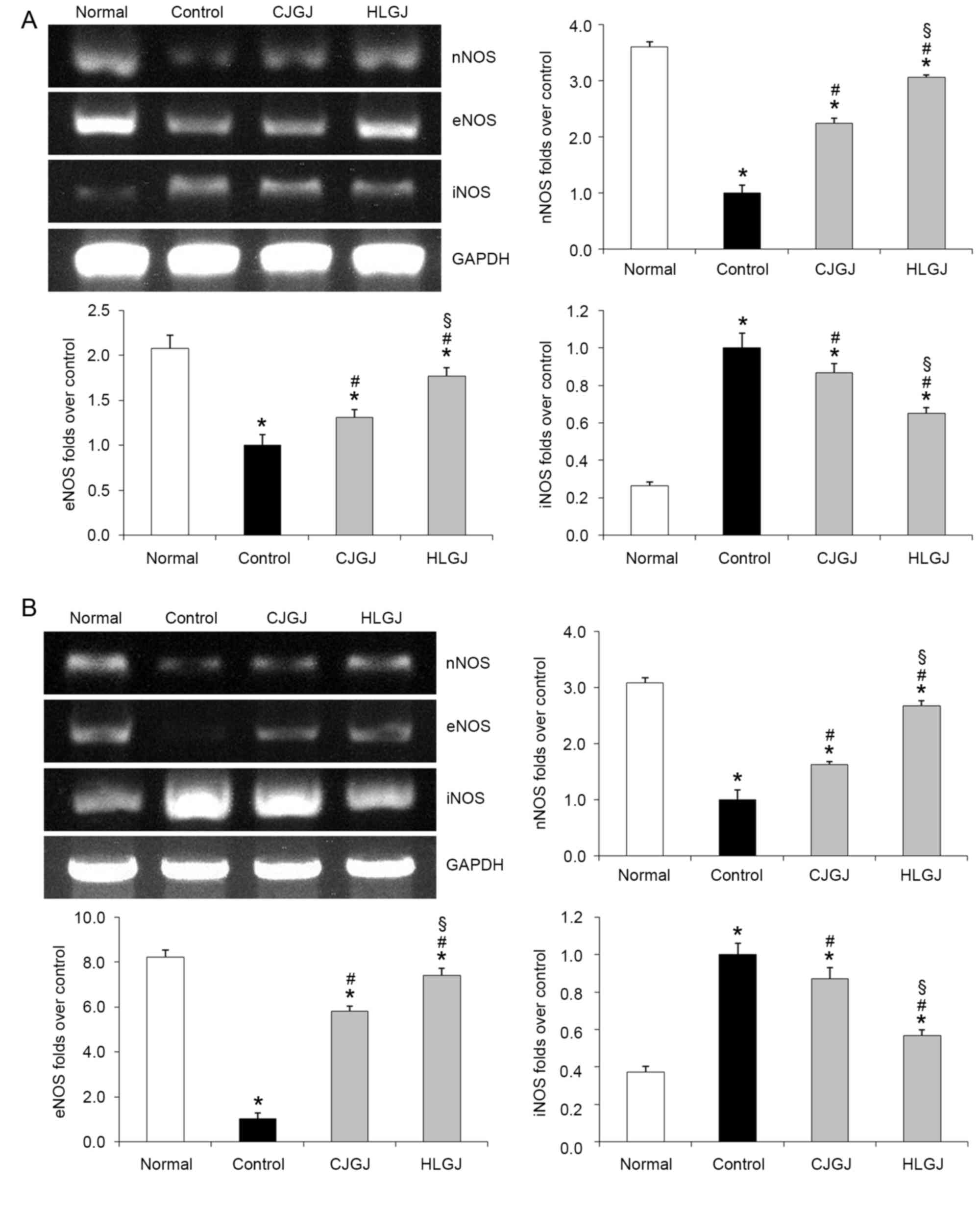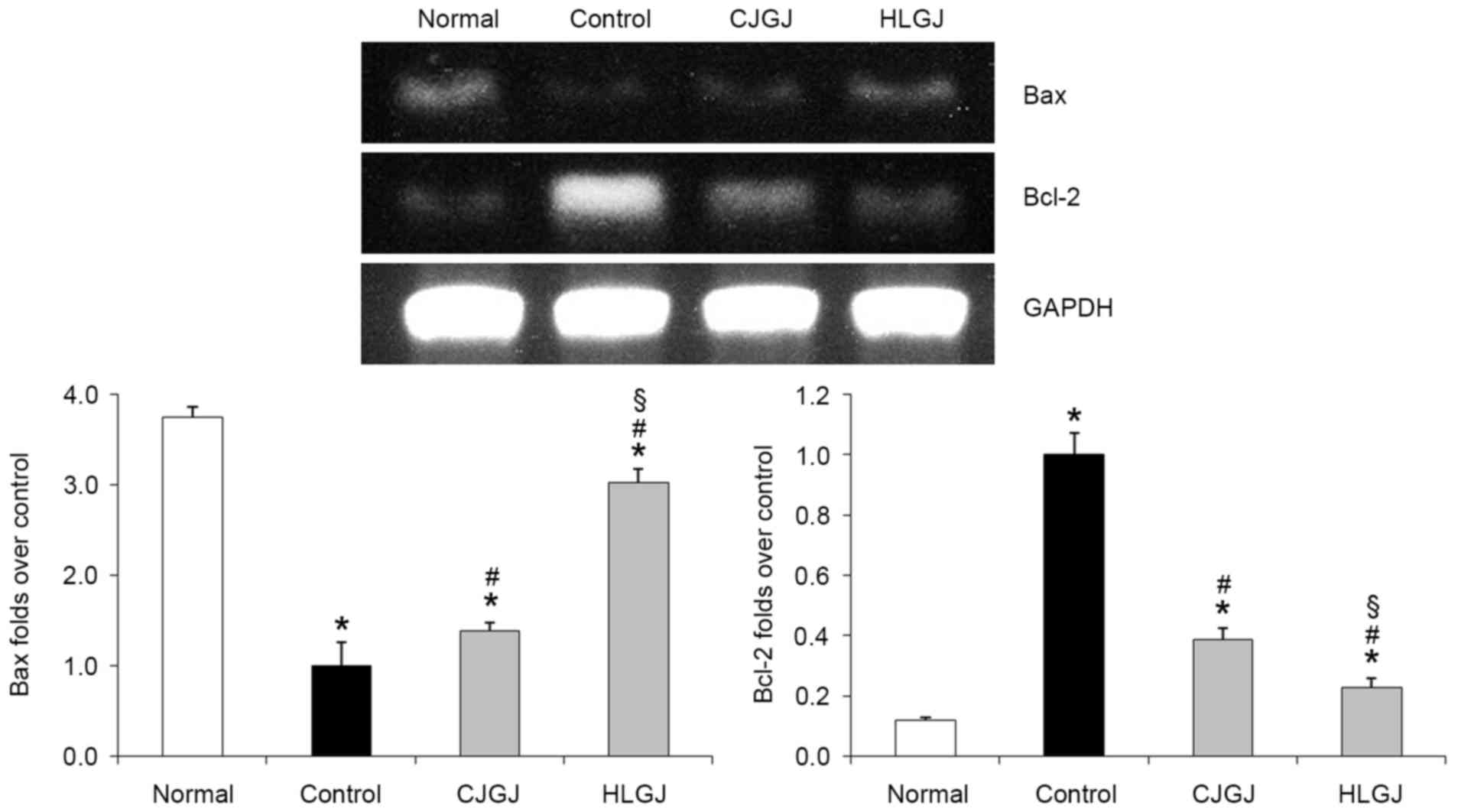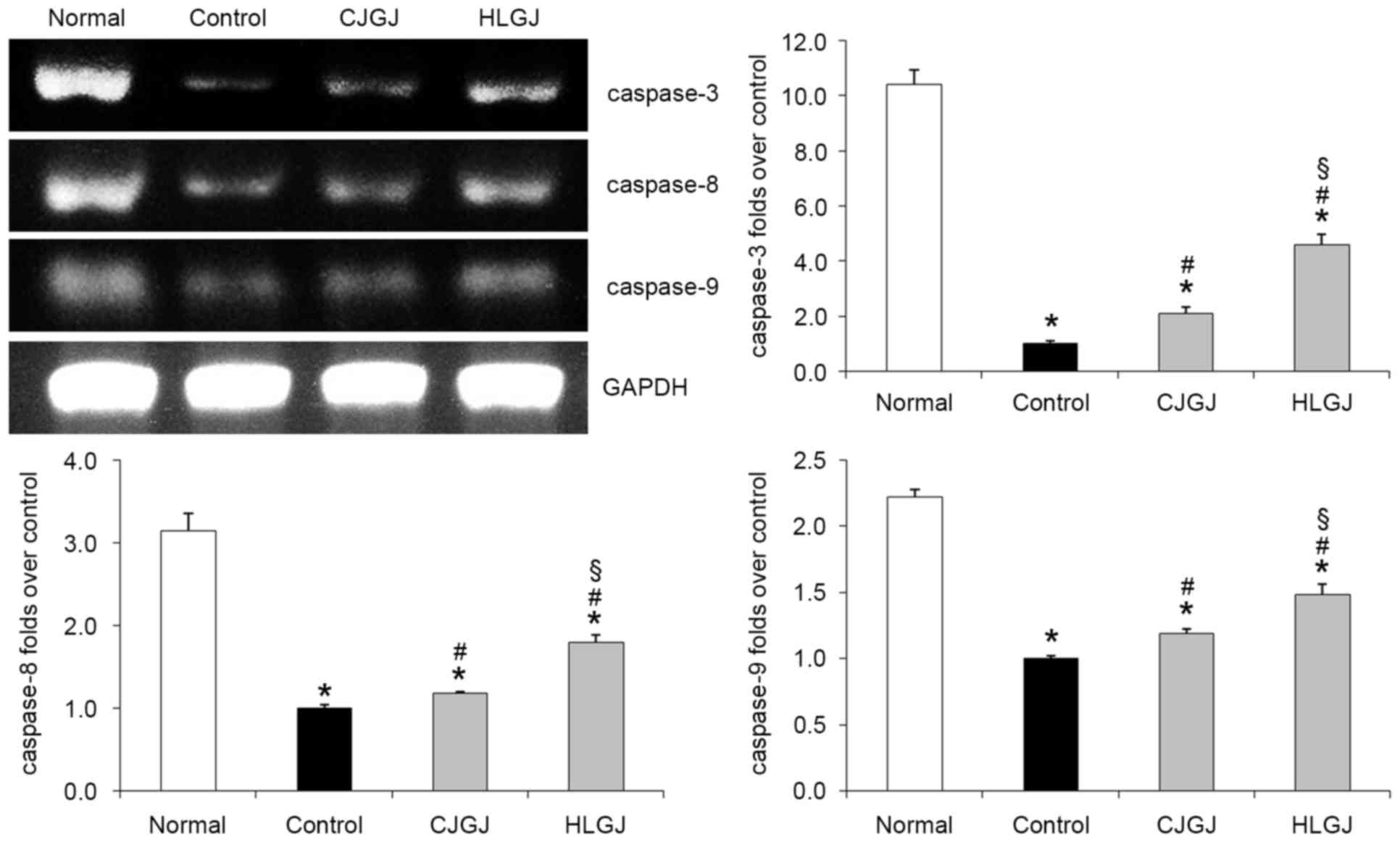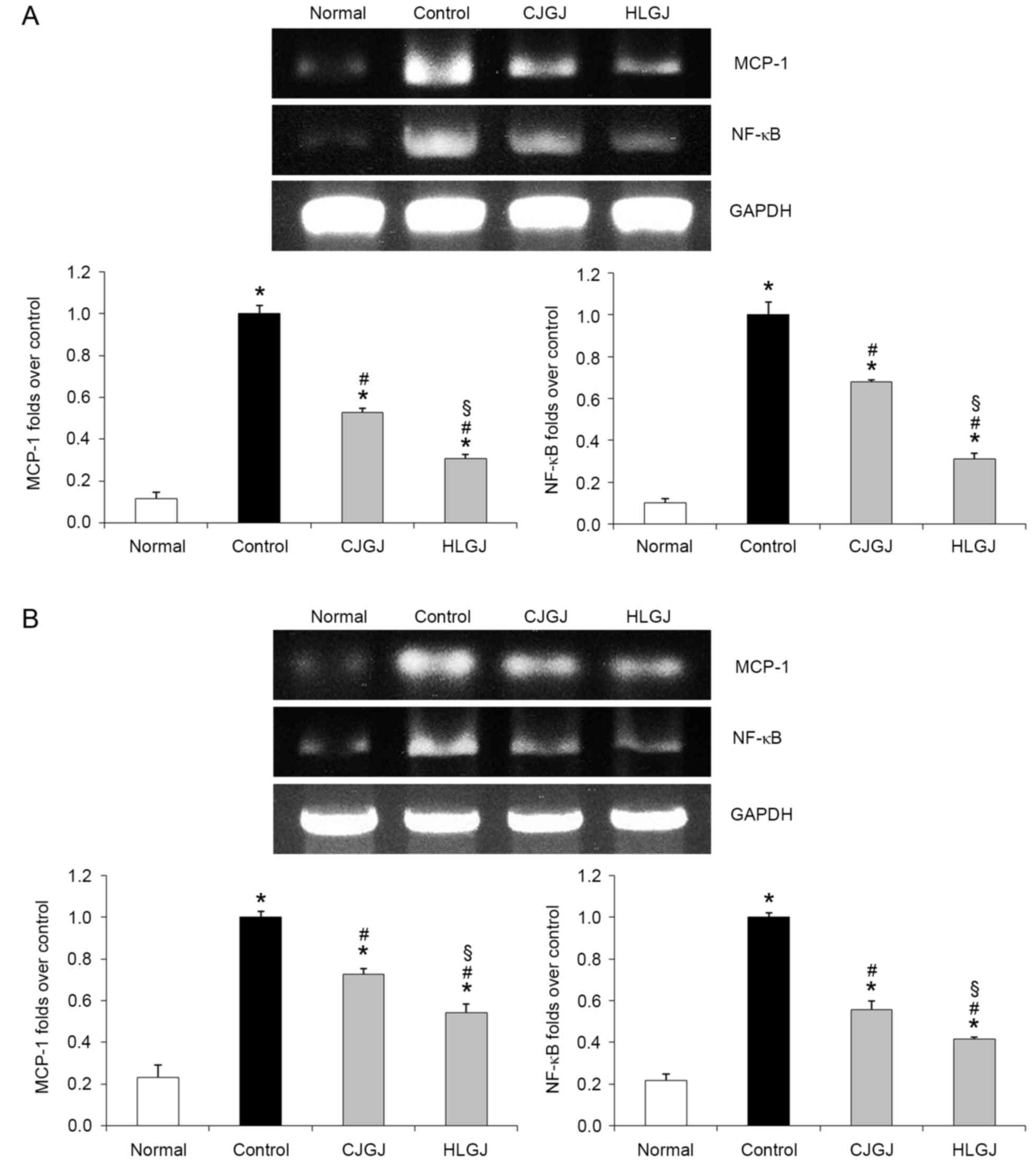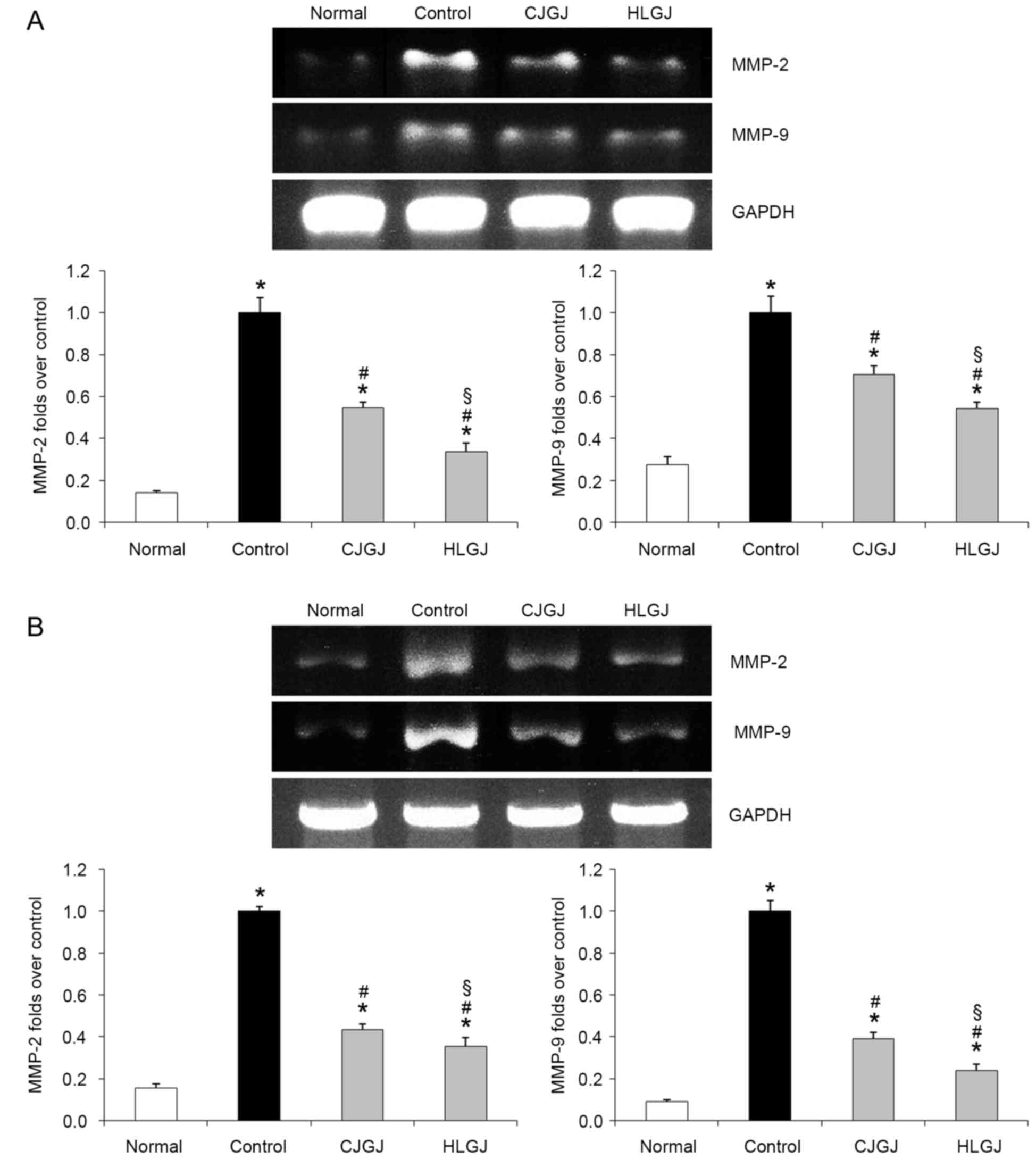|
1
|
Gu WL, Shi ZX, Yu YX, Wu YW, Lu BW and Hui
KK: Distribution characteristics of syndrome types in essential
hypertension. Zhong Xi Yi Jie He Xue Bao. 8:842–847. 2010.(In
Chinese). View Article : Google Scholar
|
|
2
|
Xu HY and Wang YQ: Investigation and
application for the therapy of hypertension with traditional
Chinese medicine. China Prac Med. 3:189–192. 2008.(In Chinese).
|
|
3
|
Shen CZ, Peng MC, Kuang HR and Cheng ZQ:
The effect of Chinese food therapy on the quality of life in
patients with hypertension. Chin J Nurs. 44:510–513. 2009.(In
Chinese).
|
|
4
|
Jiang CX, Cheng JG and Luo T: Nutritional
value analysis of medicinal and edible plant. J Anhui Agri Sci.
43:282–284. 2015.
|
|
5
|
Meng XL, Li HW, Li Y, Yu Q, Wan LL and Guo
C: Advances in Studies on chemical constituents and pharmacological
activities of Gardenia jasminoides. Chinese J New Drug. 20:959–967.
2011.
|
|
6
|
Chen H, Xiao YQ, Li L and Zhang C: Studies
on chemical constituents in fruit of Gardenia jasminoides. Zhongguo
Zhong Yao Za Zhi. 32:1041–1043. 2007.(In Chinese).
|
|
7
|
Chen SC, Shi HY, Yang N and Wang R:
Comparison of main effective constituent content of Gardenia
jasminoides in Chongqing Hou-shan and other domestic areas. China J
Exp Tradit Med Formulae. 18:131–134. 2012.(In Chinese).
|
|
8
|
Thomsen K, Rubin I and Lauritzen M: NO-
and non-NO-, non-prostanoid-dependent vasodilatation in rat sciatic
nerve during maturation and developing experimental diabetic
neuropathy. J Physiol. 543:977–993. 2002. View Article : Google Scholar :
|
|
9
|
Gangula P, Ravella K, Chukkapalli S,
Rivera M, Srinivasan S, Hale A, Channon K, Southerland J and
Kesavalu L: Polybacterial periodontal pathogens alter vascular and
gut BH4/nNOS/NRF2-phase II enzyme expression. PLoS One.
10:e01298852015. View Article : Google Scholar :
|
|
10
|
Simmonds MJ, Detterich JA and Connes P:
Nitric oxide, vasodilation and the red blood cell. Biorheology.
51:121–134. 2014.
|
|
11
|
Zhao X, Wang Q, Li J, Chen F, Qian Y and
Wang R: In vitro antioxidant, anti-mutagenic, anti-cancer and
anti-angiogenic effects of Chinese Bowl tea. J Funct Food.
7:590–598. 2014. View Article : Google Scholar
|
|
12
|
Silva I, Teixeira A, Oliveira J, Almeida
I, Almeida R and Vasconcelos C: Predictive value of vascular
disease biomarkers for digital ulcers in systemic sclerosis
patients. Clin Exp Rheumatol. 33(4 Suppl 91): S127–S130. 2015.
|
|
13
|
Gu X, Li H, Zhu X, Gu H, Chen J, Wang L,
Harding P and Xu W: Inverse correlation between plasma adropin and
ET-1 levels in essential hypertension: A cross-sectional study.
Medicine (Baltimore). 94:e17122015. View Article : Google Scholar :
|
|
14
|
Li X, Qiu J, Pan M, Zheng D, Su Y, Wei M,
Kong X, Sun W and Zhu J: Correlation between congenital heart
disease complicated with pulmonary artery hypertension and
circulating endothelial cells as well as endothelin-1. Int J Clin
Exp Pathol. 8:10743–10751. 2015.
|
|
15
|
Renga B, Cipriani S, Carino A, Simonetti
M, Zampella A and Fiorucci S: Reversal of endothelial dysfunction
by GPBAR1 agonism in portal hypertension involves a AKT/FOXOA1
dependent regulation of H2S generation and endothelin-1. PLoS One.
10:e01410822015. View Article : Google Scholar :
|
|
16
|
Feng EZ, Yang SY, Huang NX, Yin H, Zhang Y
and Tian ZX: Plasma endothelin-1 and nitric oxide correlate with
ligustrazine alleviation of pulmonary artery hypertension in
patients of chronic corpulmonale from high altitude plateau during
acute exacerbation. Zhongguo Ying Yong Sheng Li Xue Za Zhi.
30:532–527. 2014.
|
|
17
|
Basralı F, Nasırcılar Ülker S, Koçer G,
Ülker Karadamar P, Özyurt D, Cengiz M and Şentürk ÜK: Effect of
magnesium on vascular reactivity in NOS inhibition-induced
hypertension. Magnes Res. 28:64–74. 2015.
|
|
18
|
Nieto CI, Cabildo MP, Cornago MP, Sanz D,
Claramunt RM, Torralba MC, Torres MR, Elguero J, García JA, López
A, et al: Fluorination effects on NOS inhibitory activity of
pyrazoles related to curcumin. Molecules. 20:15643–15665. 2015.
View Article : Google Scholar
|
|
19
|
Kubes P and McCafferty DM: Nitric oxide
and intestinal inflammation. Am J Med. 109:150–158. 2000.
View Article : Google Scholar
|
|
20
|
Posa A, Pavo N, Hemetsberger R, Csonka C,
Csont T, Ferdinandy P, Petrási Z, Varga C, Pavo IJ, Laszlo F Jr, et
al: Protective effect of ischaemic preconditioning on
ischaemia/reperfusion-induced microvascular obstruction determined
by on-line measurements of coronary pressure and blood flow in
pigs. Thromb Haemost. 103:450–460. 2010. View Article : Google Scholar
|
|
21
|
Huang HC, Wang SS, Chang CC, Lee FY, Lin
HC, Hou MC, Teng TH, Chen YC and Lee SD: Evolution of
portal-systemic collateral vasopressin response in endotoxemic
portal hypertensive rats. Shock. 32:503–508. 2009. View Article : Google Scholar
|
|
22
|
Pulgar VM, Yamaleyeva LM, Varagic J, McGee
C, Bader M, Dechend R and Brosnihan KB: Functional changes in the
uterine artery precede the hypertensive phenotype in a transgenic
model of hypertensive pregnancy. Am J Physiol Endocrinol Metab.
309:E811–E817. 2015. View Article : Google Scholar :
|
|
23
|
Theodorakis NG, Wang YN, Korshunov VA,
Maluccio MA and Skill NJ: Thalidomide ameliorates portal
hypertension via nitric oxide synthase independent reduced systolic
blood pressure. World J Gastroenterol. 21:4126–4135. 2015.
View Article : Google Scholar :
|
|
24
|
Le Hiress M, Tu L, Ricard N, Phan C,
Thuillet R, Fadel E, Dorfmüller P, Montani D, de Man F, Humbert M,
et al: Proinflammatory signature of the dysfunctional endothelium
in pulmonary hypertension. role of the macrophage migration
inhibitory factor/CD74 complex. Am J Respir Crit Care Med.
192:983–997. 2015. View Article : Google Scholar
|
|
25
|
Zhang JL, Qin YW, Zheng X, Qiu JL, Zhang
LZ, Zhang JR and Bian JL: Relevance of serum soluble E-selectin
level and blood pressure in hypertensive patients. Shanghai Med J.
27:7–9. 2004.
|
|
26
|
Chen J and Li J: Clinical curative effect
and influence on E-selectin, iNOS, eNOS in patient of essential
hypertension with massotherapy. China J Tradit Chinese Med Pharm.
25:1708–1710. 2010.
|
|
27
|
Calò LA, Dal Maso L, Pagnin E, Ravarotto
V, Facco M, Boscaro E, Maiolino G, Pessina AC and Rossi GP: Effect
of olmesartan medoxomil on number and survival of circulating
endothelial progenitor cells and calcitonin gene related peptide in
hypertensive patients. J Hypertens. 32:193–199. 2014. View Article : Google Scholar
|
|
28
|
Wang ZG, Liu JL, Liu Y, Wen SJ, Wen J, Liu
YP, Chen XJ and Wu ZS: Increased plasma vasoactive substances and
antioxidant enzymes levels in prehypertensive patients. Zhonghua
Xin Xue Guan Bing Za Zhi. 35:719–722. 2007.(In Chinese).
|
|
29
|
Nakamura M, Han B, Nunobiki O and Kakudo
K: Adrenomedullin: A tumor progression factor via angiogenic
control. Curr Cancer Drug Targets. 6:635–643. 2006. View Article : Google Scholar
|
|
30
|
Liu K, Deng X, Gong L, Chen X, Wang S,
Chen H, Chen X, Amrit B and He S: The effect of intermedin on
angiotensin II and endothelin-1 induced ventricular myocyte
hypertrophy in neonatal rat. Clin Lab. 59:589–596. 2013. View Article : Google Scholar
|
|
31
|
Sumimoto T, Nishikimi T, Mukai M,
Matsuzaki K, Murakami E, Takishita S, Miyata A, Matsuo H and
Kangawa K: Plasma adrenomedullin concentrations and cardiac and
arterial hypertrophy in hypertension. Hypertension. 30:741–745.
1997. View Article : Google Scholar
|
|
32
|
Oie E, Vinge LE, Yndestad A, Sandberg C,
Grøgaard HK and Attramadal H: Induction of a myocardial
adrenomedullin signaling system during ischemic heart failure in
rats. Circulation. 101:415–422. 2000. View Article : Google Scholar
|
|
33
|
Sano M, Kuroi N, Nakayama T, Sato N, Izumi
Y, Soma M and Kokubun S: Association study of
calcitonin-receptor-like receptor gene in essential hypertension.
Am J Hypertens. 18:403–408. 2005. View Article : Google Scholar
|
|
34
|
Gong YS, Fan XF, Wu XM, Hu LG, Tang CS,
Pang YZ and Qi YF: Changes of intermedin/adrenomedullin 2 and its
receptors in the right ventricle of rats with chronic hypoxic
pulmonary hypertension. Sheng Li Xue Bao. 59:210–214. 2007.(In
Chinese).
|
|
35
|
Jian L, Fa X, Zhou Z and Liu S: Functional
analysis of UMOD gene and its effect on inflammatory cytokines in
serum of essential hypertension patients. Int J Clin Exp Pathol.
8:11356–11363. 2015.
|
|
36
|
Good RB, Gilbane AJ, Trinder SL, Denton
CP, Coghlan G, Abraham DJ and Holmes AM: Endothelial to mesenchymal
transition contributes to endothelial dysfunction in pulmonary
arterial hypertension. Am J Pathol. 185:1850–1858. 2015. View Article : Google Scholar
|
|
37
|
Manhiani MM, Seth DM, Banes-Berceli AK,
Satou R, Navar LG and Brands MW: The role of IL-6 in the
physiologic versus hypertensive blood pressure actions of
angiotensin II. Physiol Rep. 3:pii: e125952015. View Article : Google Scholar
|
|
38
|
Serban D, Leng J and Cheresh D: H-ras
regulates angiogenesis and vascular permeability by activation of
distinct downstream effectors. Circ Res. 102:1350–1358. 2008.
View Article : Google Scholar :
|
|
39
|
Muti LA, Pârvu AE, Crăciun AM, Miron N and
Acalovschi M: Nitro-oxidative stress, VEGF and MMP-9 in patients
with cirrhotic and non-cirrhotic portal hypertension. Clujul Med.
88:140–145. 2015. View Article : Google Scholar :
|
|
40
|
Minarchick VC, Stapleton PA, Sabolsky EM
and Nurkiewicz TR: Cerium dioxide nanoparticle exposure improves
microvascular dysfunction and reduces oxidative stress in
spontaneously hypertensive rats. Front Physiol. 6:3392015.
View Article : Google Scholar :
|
|
41
|
Zhou Y, Zhao L, Zhang Z and Lu X:
Protective effect of enalapril against methionine-enriched
diet-induced hypertension: Role of endoplasmic reticulum and
oxidative stress. Biomed Res Int. 2015:7248762015. View Article : Google Scholar :
|
|
42
|
Zhang S, Yang T, Xu X, Wang M, Zhong L,
Yang Y, Zhai Z, Xiao F and Wang C: Oxidative stress and nitric
oxide signaling related biomarkers in patients with pulmonary
hypertension: A case control study. BMC Pulm Med. 15:502015.
View Article : Google Scholar :
|
|
43
|
Pérez-de-Puig I, Martín A, Gorina R, de la
Rosa X, Martinez E and Planas AM: Induction of hemeoxygenase-1
expression after inhibition of hemeoxygenase activity promotes
inflammation and worsens ischemic brain damage in mice.
Neuroscience. 243:22–32. 2013. View Article : Google Scholar
|
|
44
|
He M, Nitti M, Piras S, Furfaro A,
Traverso N, Pronzato MA and Mann GE: Heme oxygenase-1-derived
bilirubin protects endothelial cells against high glucose-induced
damage. Free Radic Biol Med. 89:91–98. 2015. View Article : Google Scholar
|
|
45
|
Chao HM, Chuang MJ, Liu JH, Liu XQ, Ho LK,
Pan WH, Zhang XM, Liu CM, Tsai SK, Kong CW, et al: Baicalein
protects against retinal ischemia by antioxidation, antiapoptosis,
downregulation of HIF-1α, VEGF, and MMP-9 and upregulation of HO-1.
J Ocul Pharmacol Ther. 29:539–549. 2013. View Article : Google Scholar :
|
|
46
|
Li Z, Wang Y, Man RY and Vanhoutte PM:
Upregulation of heme oxygenase-1 potentiates EDH-type relaxations
in the mesenteric artery of the spontaneously hypertensive rat. Am
J Physiol Heart Circ Physiol. 305:H1471–H1483. 2013. View Article : Google Scholar
|
|
47
|
Imenshahidi M, Hosseinzadeh H and
Javadpour Y: Hypotensive effect of aqueous saffron extract (Crocus
sativus L.) and its constituents, safranal and crocin, in
normotensive and hypertensive rats. Phytother Res. 24:990–994.
2010.
|
|
48
|
Xu GL, Qian ZY, Yu SQ, Gong ZN and Shen
XC: Evidence of crocin against endothelial injury induced by
hydrogen peroxide in vitro. J Asian Nat Prod Res. 8:79–85. 2006.
View Article : Google Scholar
|
|
49
|
Chen L, Luo ZK, Peng GP, Li XH, Liu L,
Sheng XB and Wang ZG: The cardiac systolic and diastolic effects of
genipin-1-β-D-gentiobioside in the experimental heart failure.
Pharm Clin Chinese Mater Med. 29:39–41. 2013.(In Chinese).
|
|
50
|
Wang ZC, Yang XL, Zhang K and Xiao P:
Research on pharmacological activities of gardenoside. J Henan Univ
Sci Technol Med Sci. 30:159–160. 2012.
|
|
51
|
Pang H, Han B, Yu T and Peng Z: The
complex regulation of tanshinone IIA in rats with
hypertension-induced left ventricular hypertrophy. PLoS One.
9:e922162014. View Article : Google Scholar :
|
|
52
|
Wang HT, Liu CF, Tsai TH, Chen YL, Chang
HW, Tsai CY, Leu S, Zhen YY, Chai HT, Chung SY, et al: Effect of
obesity reduction on preservation of heart function and attenuation
of left ventricular remodeling, oxidative stress and inflammation
in obese mice. J Transl Med. 10:1452012. View Article : Google Scholar :
|
|
53
|
Kolwicz SC, MacDonnell SM, Renna BF, Reger
PO, Seqqat R, Rafiq K, Kendrick ZV, Houser SR, Sabri A and Libonati
JR: Left ventricular remodeling with exercise in hypertension. Am J
Physiol Heart Circ Physiol. 297:H1361–H1368. 2009. View Article : Google Scholar :
|
|
54
|
Favaloro B, Allocati N, Graziano V, Di
Ilio C and De Laurenzi V: Role of apoptosis in disease. Aging
(Albany NY). 4:330–349. 2012. View Article : Google Scholar :
|
|
55
|
Liu Y, Wang S, Wang C, Song H, Han H, Hang
P, Jiang Y, Wei L, Huo R, Sun L, et al: Upregulation of M3
muscarinic receptor inhibits cardiac hypertrophy induced by
angiotensin II. J Transl Med. 11:2092013. View Article : Google Scholar :
|
|
56
|
Shi XC, Liu W, Wang J and Zhao YQ: Effect
of the Tianma Gouteng regulating the protein expression of Bax and
Caspase-3 of myocardial tissue in spontaneously hypertensive rats.
Tianjin J Tradi Chinese Med. 33:354–357, (In Chinese).
|
|
57
|
Jing X, Chen SS, Jing W, Tan Q, Yu MX and
Tu JC: Diagnostic potential of differentially expressed homer1,
IL-1β, and TNF-α in coronary artery disease. Int J Mol Sci.
16:535–546. 2014. View Article : Google Scholar :
|
|
58
|
Zhu XY, Chade AR, Krier J, Daghini E, Lavi
E, Guglielmotti A, Lerman A and Lerman LO: The chemokine monocyte
chemoattractant protein-1 contributes to renal dysfunction in swine
renovascular hypertension. J Hypertens. 27:2063–2073. 2009.
View Article : Google Scholar :
|
|
59
|
Fu L, Das B, Mathew S and Shi YB:
Genome-wide identification of Xenopus matrix metalloproteinases:
Conservation and unique duplications in amphibians. BMC Genomics.
10:812009. View Article : Google Scholar :
|
|
60
|
Raffetto JD and Khalil RA: Matrix
metalloproteinases and their inhibitors in vascular remodeling and
vascular disease. Biochem Pharmacol. 75:346–359. 2008. View Article : Google Scholar
|
|
61
|
Givvimani S, Munjal C, Tyagi N, Sen U,
Metreveli N and Tyagi SC: Mitochondrial division/mitophagy
inhibitor (mdivi) ameliorates pressure overload induced heart
failure. PLoS One. 7:e323882012. View Article : Google Scholar :
|
|
62
|
Li W, Mata KM, Mazzuca MQ and Khalil RA:
Altered matrix metalloproteinase-2 and −9 expression/activity links
placental ischemia and anti-angiogenic sFlt-1 to uteroplacental and
vascular remodeling and collagen deposition in hypertensive
pregnancy. Biochem Pharmacol. 89:370–385. 2014. View Article : Google Scholar :
|
|
63
|
Kluknavsky M, Balis P, Puzserova A,
Radosinska J, Berenyiova A, Drobna M, Lukac S, Muchova J and
Bernatova I: (−)-Epicatechin prevents blood pressure increase and
reduces locomotor hyperactivity in young spontaneously hypertensive
rats. Oxid Med Cell Longev. 2016:69490202016. View Article : Google Scholar :
|
|
64
|
Belo VA, Parente JM, Tanus-Santos JE and
Castro MM: Matrix metalloproteinase (MMP)-2 decreases calponin-1
levels and contributes to arterial remodeling in early
hypertension. Biochem Pharmacol. 118:50–58. 2016. View Article : Google Scholar
|
|
65
|
Akinrinde AS, Oyagbemi AA, Omobowale TO,
Asenuga ER and Ajibade TO: Alterations in blood pressure,
antioxidant status and caspase 8 expression in cobalt
chloride-induced cardio-renal dysfunction are reversed by Ocimum
gratissimum and gallic acid in Wistar rats. J Trace Elem Med Biol.
36:27–37. 2016. View Article : Google Scholar
|



